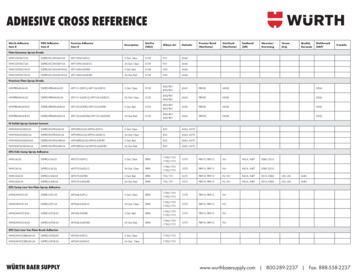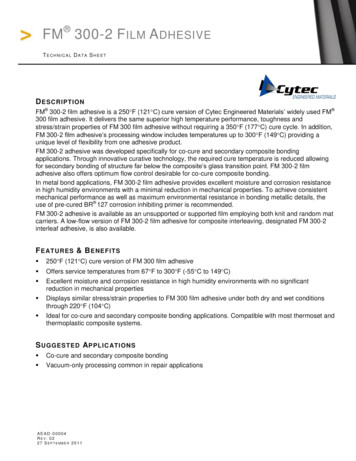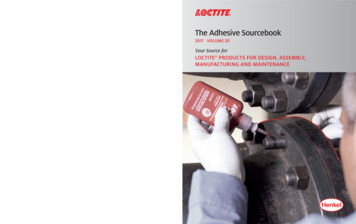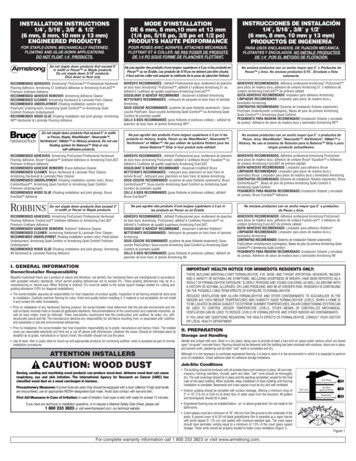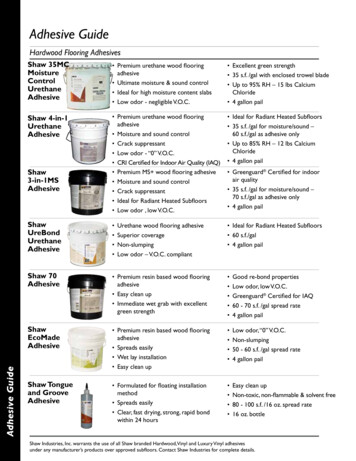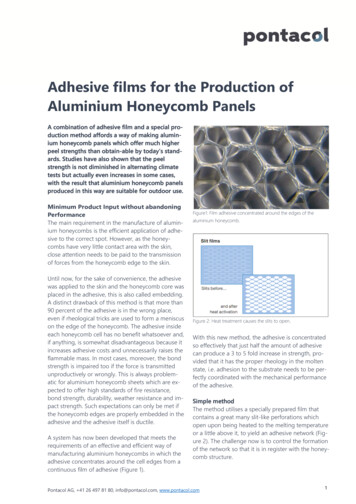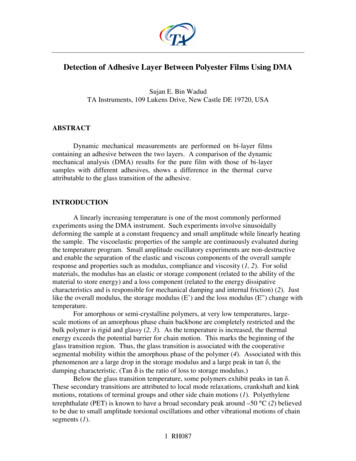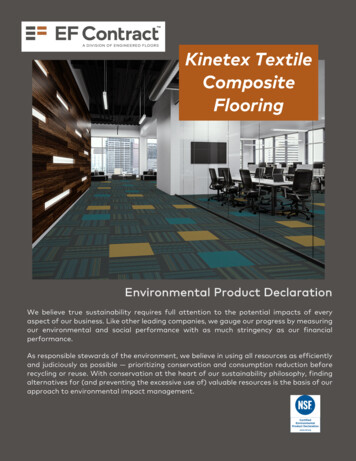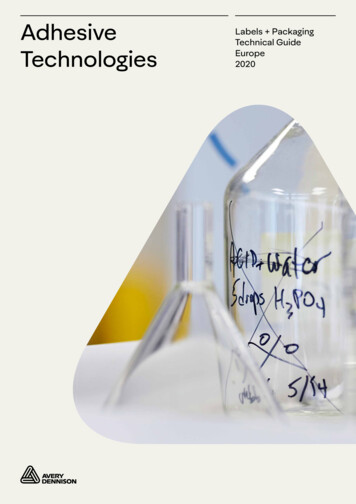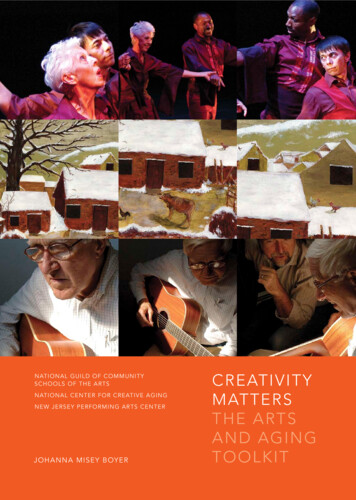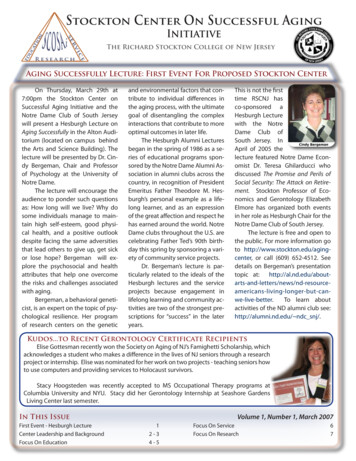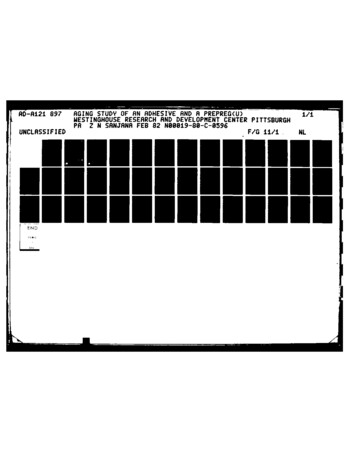
Transcription
A-A12l 897LAGING STUDY OF AN ADHESIVE AND A PREPREG(U)WESTINGHOUSE RESEARCH AND DEVELOPMENT CENTER PITTSBURGHPA Z N SANJANA FEB 82 N88819-8-C-8596F/GNCLSSFIEDi/iN
El)SMICROCOPYRESOLUTION TEST CHART.Oiii." :"1 .5 1.411.6
AGING STUDY OF AN ADHESIVEAND A PREPREGZ. N. SanJanaPrincipal Investigator00Final Report for the Period18 Sept. 1980 to 18 Dec. 1981Contract No. N00019-80-C-0596February 1982Department of the NavyNaval Air Systems CommndWashington, D.C. 20361APPROVED FOR PUBLICRLNEASE; DISIUJTIOUUNLIMITEDDTICELECTEDS.,Welhngouss R&D Center13M Beulah RoadPittsburgh, Pennsylvania 1523582 ii29D065
AGING STUDY OF AN ADHESIVEAND A PREPREGZ. N. SanjanaPrincipal InvestigatorFinal Report for the Period18 Sept. 1980 to 18 Dec. 1981Contract No. N00019-80-C-0596February 1982Department of the NavyNaval Air Systems CommandWashington, D.C. 20361APPROVED FOR PUBLICRELEASE; DISTRIBUTIONNTISDXC ability CodesAvail and/orMst specialI-eWestinghouse R&D Center1310 Beulah RoadPittsburgh, Pennsylvania 15235
SECURITYCLASSIFICATION OF THIS PAGE (When Veo Entered)REPORT DOCUMENTATION PAGEREAD INSTRUCTIONSBEFORE COMPLETING FORMIREPORT NUMBER2. GOVT ACCESSION NO3.4. TITLE (and Subtitlo)RECIPIENT'S CATALOG NUMBERSAging Study Of An Adhesive and A Prepreg6.7.AUTmOR(s)%Z.TYPE OF REPORT & PERIOD COVEREDFinal Report for the period18 Sept. 80 to 18 Dec. 1981PERFORMING ORO. REPORT NUMBERI9. CONTRACT Olt GRANT NUMDER(s)N. SanjanaN00019-80-C-05969. PERFORMING ORGANIZATION NAME AND ADDRESS10. PROGRAM ELEMENT. PROJECT. TASKW estinghouse R&D Centeri',AREA & WORK UNIT NUMBERS1310 Beulah Road""Pittsburgh, PA1523511. CONTROLLING OFFICE NAME AND aDORES-i12.REPORT DATEFeb. 1982II. NUMBERMONITORING AGENCY NAME A ADORESS(Il different from Controllnd Office)14Department of the NavyDISTRIBUTION STATEMENTIS. SECURITY CLASS. (of this report)UnclassifiedNaval Air Systems CommandNava Cmman15S.AirSystmsWashington, D.C. 2036116.OF PAGESDECLASSIFICATIONi DOWNGRADINGSCHEDULE(of this Report)APPROVED FOR PUBLIC RELEASE; DISTRIBUTION UNLIMITED.17.s.DISTRIBUTION STATEMENT(of the abstract entered In Block 20, if dilffrrt from Report)SUPPLEMENTARY NOTESI9.KEY WORDS (Coninu.20.ABSTRACT (Continue on rovers* side If necossary md !dentify by block number)on rovers* side if ncessary and Identify by block number)See attached.DD,o1473UnclassifiedEDITION OF I NOV 6S isOBSOLETEiSECURITY CLASSIFICATION OF THIS PAGE ("hen Dote Enetredi
Block No. 20 (Abstract)Prepregs and adhesive films which are B-stage products are usedextensively in the aerospace, electrical, and communications industries.They consist of a partially reacted mixture of monomers which have beenimpregnated into the reinforcement. During shipping and storage, priorto use, the reactions will continue. The amount of reaction or "age"of the prepreg will depend on the conditions (temperature, humidity andtim)tatit has been exposed to.This report provides data and results of studies performed onAmerican Cyanamid's FM300 adhesive film aged under diverse conditions oftemperature, time and humidity. At various times during the aging, physical*propertiesof the adhesive were measured and the following methods wereused to track the age of the adhesive: (1) dielectric analysis (DA),(2) dynamic mechanical analysis (DMA), and (3) a simple, easy to usetime-temperature integrating device (TNW) which is carried with thematerial and provides a visual observation of the time and temperatureexposure of the adhesive. It was found that DA, DMA, and the TTN canbe used to follow the age of the adhesive and that they can be used asoverage indicators to tell the user when the adhesive has lost itsuseful life. The indication by the TTN is less exact than by the othertwo methods.Agstudies on Avco 5505-4 boron-epoxy prepreg were initiated.Testing is as yet incomplete and therefore the results will be presentedin a future report.L
FOREWORDThe following final report describes work performed on NASCContract No. N00019-80-C-0596, "Aging Study of An Adhesive and aPrepreg".The work accomplished and reported herein was performed byWestinghouse Electric Corp., R&D Center.The program was administeredby R. Dempsey for the Naval Air Systems Command.The program was conducted in the Polymers and PlasticsDepartment, J. D. B. Smith, Manager, with Z. N. Sanjana as principalinvestigator.This report covers the contract period 18 September 1980to 18 December 1981.o,.,ii.-.
TABLE OF CONTENTSSECTION1.PAGEINTRODUCTION12. SUMMARY3.3AdhesiveTests of Age IndicatorsTests of Adhesive Performance344EXPERIMENTAL53.13.2MaterialsOverage Indicators553.33.2.1 Time-Temperature Integrators (TTW)3.2.2 Dielectric Analysis (DA)3.2.3 Dynamic Mechanical Analysis (DMA)Adhesive Performance56673.3.13.3.2Adhesive FlowLap Shear Strength of Aluminum-to-73.3.3Aluminum JointsClimbing Drum Peel Strength894. RESULTS AND DISCUSSION104.1120*F, 20% RH Aging104.24.34.4120 0 F, 80% RH Aging140*F, 80% RH AgingSummary of FM300 Aging1112135.AGING OF AVCO 5505-4 BORON-EPOXY PREPREG146.CONCLUSIONS157.REFERENCES16iv ' ' . . ,"-.i" ,,5'.-: 2 2"-. 2'-.-o. ? .o2 .--. i.%. . .' - .ii.i - ,:-,i-.--.---ii:--.:.- ." ,.-
LIST OF ILLUSTRATIONSFIGURE1Aging at 120*F and 20% R.H.adhesive (Lot B-360)Flow and TTW data for FM3002Aging at 120*F and 20% R.H.Climbing drum peel strength andDMA data for FM300 adhesive (Lot B-360)"*I,Dielectric analysis data for3Aging at 120 F and 20% R.H.FM300 adhesive (Lot B-360)4Aging at 120 F, 20% R.H.adhesive (Lot B-360)5Aging at 120 F with 80% R.H. TTW and flow data for FM300adhesive (-o- Lot B-377, -A- Lot B-360)6Aging at 120*F with 80% R.H. DMA and climbing drum peelstrength data for FM300 adhesive (-o- Lot B-377, -A- Lot B-360)7Aging at 120 F with 80% R.H. Dielectric analysis data for(-o- Lot B-377, -A- Lot B-360)FM300 adhesive8Aging at 120*F with 80% R.H. Lap shear strength data forFM300 adhesive (-o- Lot B-377, -A- Lot B-360)9Aging at 140*F and 80% R.H. Flow and TTW data for FM300adhesive (-o- Lot B-377, -A- Lot B-360)Lap shear strength data for FM300Climbing drum peel strength and(-o- Lot B-377, -A- Lot B-360)10Aging at 140*F and 80% R.H.DMA data for FM300 adhesive11Aging at 140*F and 80% R.H. Dielectric analysis data for(-o- Lot B-377, -A- Lot B-360)FM300 adhesive12Aging at 140*F and 80% R.H. Lap shear strength data forFM300 adhesive (-o- Lot B-377, -A- Lot B-360)13FM300 End of storage life[v
1. INTRODUCTIONThe use of non-metallic materials for structural applicationsin high performance military aircraft is expanding.The principal non-metallics used are advanced composites and adhesives.The advanced com-posite material (usually graphite-epoxy) for structrual application isgenerally obtained from the supplier as a prepreg or a B-staged product.The adhesive is often used in a film form which consists of a B-stagedproduct carried on a carrier cloth.These materials consist of a partially reacted mixture ofmonomers which have been impregnated into the reinforcement or carrier.During shipping and storage, prior to use, the reactions will continue.The amount of reaction or "age" of the material will depend on the conditions (principally, temperature, humidity and time) that it has beenexposed to.These conditions are often unknown.At a point in the ageof the prepreg, some critical property or properties will deteriorate.This would then represent the end of the useful life of the prepreg.An overage indicator should reliably inform the user of aprepreg when its useful life is over.This requires that the usefullife of the prepreg be defined.With an epoxy system, this often dependson the end use for the prepreg.If the user is only interested in makingflat laminates, for example, the prepreg can be used well after the pointat which it becomes stiff and boardy.If, however, the use requireslaying up the prepreg in a complex shape, it must be soft and tacky sothat it can be draped and it can adhere to itself. In general, the endpoint of the useful life of a prepreg occurs when some critical propertybegins to be adversely affected.The critical property concerned willdepend upon the end use intended for the product.apply to adhesives.1Similar considerations
The overage indicator then may be either the critical property4itself or some other measurement which correlates well with the loss ofthe critical property.The latter affords more flexibility andgenerality of application since, as observed above, the critical propertycould change depending on the material and the end use.It is particularly necessary to know the age of the materialif it is to be used under field conditions (such as at a remote base oron an aircraft carrier) to effect repairs to a composite structure.In such situations, the prepreg or adhesive is used infrequently and longperiods of storage are possible.Exhaustive testing of the materialprior to use is not feasible and an overage indicator would be most.4useful. A simple overage indicator would obviously have the greatestadvantage for field use whereas a more complex, rigorous test would be*more appropriate for in-plant use.This report concludes the aging studies carried out on FM300*adhesive.In a previous report l, data on aging of FM300 under threedifferent conditions was presented.This report presents data on agingthe adhesive under three additional conditions and on two batches ofadhesive.Several methods are described which successfully track theage of the adhesive and which can be used as overage indicators.Theseare dielectric analysis (DA), dynamic mechanical analysis (DMA), anda time-temperature integrating indicator (TNW).The latter is a simpledevice which is carried with the prepreg and should be most useful forfield use.The other two methods, while simple to use, requireanalytical equipment. The TTN is no longer being manufactured; therefore,an alternative should be evaluated.The present work reported in this document is a continuation(1-3)of effort reported earlierand therefore should be read inconjunction with these reports.2
2.SUMMARYThe method used in this study was to determine (for a givenmaterial) that critical property which is the first to deteriorate whenthe material is aged in shipping, storage, and handling.Various techniquesare then used to track the aging of the prepreg under diverse storageconditions.The results obtained are correlated to the deterioration inthe critical property.Thus each technique provides a number (or value)which is then used as a decision point to reject that lot of material ashaving exhausted its useful life.Under the present contract the material examined is FM300adhesive supplied by American Cyanamid Corp., Havre de Grace, Maryland.For the adhesive the critical property should be determined by thesupplier and user but our tests indicate that adhesive flow is the firstproperty to deteriorate with aging of the unreacted adhesive film.Thefirst mechanical property to deteriorate is climbing drum peel strength,and we used it as the critical property.AdhesiveAging studies on adhesives were initiated during the lastperiod and were completed in this reporting period.An epoxy filmadhesive - FM300 from American Cyanamid - was selected for study.Theuncured epoxy film adhesive as-received was aged at the followingconditions:a. 100 F 10% RHb.100 F 80% RHc.Laboratory ambient (72*F 35% RH average conditions).Results for the above conditions were reported earlier. (1)In thisreport data on aging of the film adhesive under the following conditionsis presented:d.120 F 20% RHe. 120*F 80% RHf. 140OF 80% RH3
During the aging of the adhesive under the above conditions,the following tests were performed:Tests of Age IndicatorsTime Temperature Integrator (TTW):Several types of indicatorscalled Time-Temperature Watch were obtained and exposed to the sameaging conditions as the adhesive.The purpose was to see if under diverseaging conditions, the devices would track the age of the adhesive andwould provide a value which would correlate with the loss of thecritical property.-*measurementsDielectric Analysis (DA):During the aging, at periodic intervals,were made on the adhesive using an automatic dielectrometer.The measurements were made under dynamic temperature conditions to obtainthe temperature of the relaxation peak in dissipation factor.-Dynamic Mechanical Analysis (DMA):At periodic intervals duringthe aging, the temperature of the relatT.ve damping peak was obtainedusing a dynamic mechanical analyzer (DuPont Model 980).Tests of Adhesive PerformanceAt periodic intervals during the aging of the adhesive, thefollowing properties were measured:-Flow at 40 psi on predried samples.-Lap shear strength of aluminum-to-aluminum joints.Three conditions0were used to test the joints: (1) @ 250 F, (2) @ 250OF after 24 hrs at250*F, and (3) @ 200 F after 24 hrs water boil.-Peel strength of the tool-side face of bonded honeycomb panels usinga climbing drum test procedure.Results of the tests on indicators and on adhesive performancewere correlated to determine the critical property of the adhesive andto determine if the overage indicators would provide a single value for theend of the useful life of the adhesive under diverse aging conditions.4
3. EXPERIMENTAL3.1MATERIALSFM300 adhesive manufactured by the Bloomingdale Division ofAmerican Cyanamid Corp. was selected to determine if the various overageindicators developed for prepreg could also be used with adhesives.Theselection of this adhesive for study was based on its extensive use innaval aircraft.All of the work reported here was performed on one batchof FM300 adhesive film of nominal weight 0.10 lbs/ft 2 which was orderedto meet McDonnell Douglas Specification MMS350 Type 1. The batch numberwas B-360.During the investigation, another batch of material (B-377)was ordered.Our tests showed this material to be much more advanced thanthe material from B-360. The supplier was contacted about the high stateof advancement of the material received from batch B-377 and their recordsshow that the roll received by us was impregnated at the end of the batchand that this would result in a higher state of advancement, even thoughit met specifications.It was decided to age both lots of material forthe aging studies performed at 120*F, 80% RH and 140*F, 80% RH.Thiswas done to observe the effect on aging characteristics of lot-to-lotvariations.Within this report the lots are identified by theirbatch numbers.3.2OVERAGE INDICATORS3.2.1Time-Temperature Integrators (TTW)These integrators are devices that integrate the time andtemperature to which they have been exposed and display the integratedproduct as a color change on a numbered strip.The change in color maythen be correlated to the end of the useful life of the prepreg oradhesive, or, in general, to any material that ages during shippingand storage.One type of integrator was investigated in the course of thisstudy.It is called Time-Temperature Watch (TTW) and is supplied by theInfo-Chem Division of Akzona, Inc.The supplier is no longer marketing5
Lthis device but since many of the tests were completed, it was decided toreport the data.Another time-cemperature integrator manufactured by AlliedCorporation is being evaluated for this application as a substitute for theTTW.Results of this evaluation will be presented in the next report.In the previous reports(2,3)2,it was concluded that a Type 33TTW was appropriate for use as an overage indicator for 3501-6/AS prepreg.Type 30, 33 and 39 TTWs were evaluated during the aging studies onFM300 adhesive.3.2.2Dielectric Analysis (DA)An automatic dielectrometer (Tetrahedron, Audrey II, Model 203)was used to monitor the aging of adhesive film and to define an overagecondition for the materials.The procedure and techniques used weredescribed in detail in References 2 and 4.In brief, measurements aremade in the temperature variant mode at a rate of 10C/min and 1 kHzfrequency.The sample used consists of 1 ply of adhesive film (driedin a desiccator for at least two hrs) under 1 ply of 1 mil thickpolyimide film and the temperature of the first peak in dissipationfactor is measured.3.2.3This peak increases with age of the material.Dynamic Mechanical Analysis (DMA)A DuPont Instruments, 980 Dynamic Mechanical Analyzer was usedto measure the change in prepreg age as described in detail in References2 and 5.If brief, a 1" x 1/2" sample of prepreg is cut, dried in adesiccator for a minimum of two hrs and then placed in the clamps of theDMA.The DMA is then cooled to -20*C after which it is heated at aprogrammed rate of 5 C/min.As the prepreg heats up it undergoes atransition which results in a peak in the relative damping curve.Thetemperature of this peak was successfully used to characterize the ageof the prepreg.As the prepreg ages, the temperature of the peak inrelative damping increases.6
3.3ADHESIVE PERFORMANCEDue to the limited scope of this program it was decided tolimit tests of adhesive performance to key tests which are most likelyto be affected by adhesive age.It is generally believed that theprincipal effect of environmental aging on the uncured adhesive film isto reduce its flow.Thus, bonding performance that is most affected byadhesive flow should suffer the earliest degradation due to aging ofthe uncured adhesive film.Therefore, the following performance tests were decided upon inconsultation with NAVAIR and are described here.3.3.1(a)Adhesive FlowSix 1.5" diameter discs of the adhesive were stamped out with a die.(b) The area of the six discs were measured using a compensating polarplanimeter.(c) The release liner was removed and the six discs were placed in avacuum desiccator containing dry desiccant for between two tothree hrs.(d)The discs were removed from desiccator, the paper support wasremoved and they were placed at least 4" apart between two sheetsof Mylar.The sandwich was placed between stainless steel platesand in an autoclave.(e) Autoclave pressure was adjusted so that a true pressure of40 2 psi was applied to the disc.The autoclave was heated atabout 5*F/min to 350 5*F and held at temperature and pressurefor 60 mins.(f) The autoclave was then cooled to under 150*F while maintaining thepressure; after venting the discs sandwiched between the Mylarsheets were removed from the autoclave.7
(g) Area of each specimen was measured using a compensating polarplanimeter.(h) The percent flow was calculated as%Final3.3.2Area - Original AreaOriginal Areax 100Lap Shear Strength of Aluminum-to-Aluminum JointsAt periodic intervals during adhesive aging, samples of theadhesive were removed from the aging environment and were used to formlap shear joints with 7075-T6 bare aluminum alloy.The aluminum surface was prepared for bonding as follows:The panels were vapor degreased and then immersed in alkaline cleaner ata temperature of 150 50 F for 15 mins.rinsed in tap water and deionized water.The panels were then immediatelyThey were then etched ina sodium dichromate/sulfuric acid solution maintained at 155 50 F for15 mins.On removal from the acid bath the panels were immediately rinsedin tap water and deionized water at which point the panels were checkedfor water-breaks and those not free of water-breaks were reprocessed.The panels were then dried in an air-circulating oven at 140*F. Thisprocedure is in general accord with ASTM D2651-79, "Standard Practicefor Preparation of Metal Surfaces for Adhesive Bonding".Within two hours of drying the panels were primed using BR127primer. The primer was kept in a freezer at 00 F and was not aged in anyPrior to use the primer was allowed to warm to room temperature onIway.a roller mixer.This allowed thorough mixing and suspension of theprimer and vehicle.The primer was sprayed on to the panels using anair sprayer to provide a cured thickness of about 0.0002". The primerwas allowed to air dry for 30 mins and was then cured for 45 10 minsat 250*F.The primed panels were allowed to cool, stacked with kraftpaper between each panel and were then packed in sealed polyethylenebags until needed for bonding.*8--1.
Plates 9" long by 4" wide were bonded together to L'arm standardlap shear strength specimens - 7" long with a 1/2" bonded overlap.The9" plate yielded seven 1" wide standard specimens and the edges werediscarded.The adhesive was applied to the area to be bonded and thejoint was press cured at a pressure of 50 psi.The joint was heated to3500 5 F at about 5*F/min and allowed to cure for 75 15 mins.Pressure was maintained during cool down to room temperature.It wasdecided to use a press instead of an autoclave so as to allow the jointto form without any bondline control.Then the adhesive as it aged wouldflow less, form a thicker bondline and therefore form weaker bonds.After being cut into 1" wide specimens the joints were testedin accordance with ASTM D1002 to obtain the lap shear strength.replicates were used per test.FiveThree conditions were used to test thebonds formed by the adhesive: (1) @ 250*F, (2) @ 250 F after 24 hrs at250 F, and (3) @ 200*F after 24 hrs water boil.Climbing Drum Peel Strength3.3.3The peel strength of adhesively bonded facing skins to thecore is affected by adhesive flow because a large part of the bond strengthof the panel is due to the adhesive flowing into the core and up thesides of the core ribbons to form a fillet.As the adhesive ages itsmolecular weight increases and its viscosity at any temperature increases,therefore its ability to flow into the honeycomb core and form the bondis reduced.This is particularly noticed on the lower face (or tool face)of the panel because at that face the adhesive has to flow up the coreribbon surface utilizing surface tension forces, without the assistanceof gravity.(1)The peel strength of the adhesive was obtained during theaging of the adhesive film by periodically removing the adhesive fromthe aging environment and using it to bond honeycomb panels.Facing skins were cut from 2024-T3 bare aluminum and werecleaned, acid etched and primed as discussed in Section 3.3.2.9The
core was cut from 0.625" thick, 3/16" cell size honeycomb of 0.002" foilthickness 5056-H139 aluminum.Panels were molded in 12" by 10" size toyield three specimens 12" by 3". The core ribbon direction and filmcarrier warp direction were kept parallel to the 12" dimension and theadhesive was so placed that the polyethylene liner side was kept againstthe core.The panels were bonded in a press at 50 psi pressure. The curetemperature of 3500 5*F was reached at a rate of about 5*F per minuteand was held for 75 15 mins. After cooling under pressure the specimenswere cut and tested for the climbing drum peel strength at room temperature according to ASTM D1781-76. The strength is reported in in.-lbs/in.width for an average and standard deviation of six samples per test.4. RESULTS AND DISCUSSIONData from the aging studies is presented in graphical form inFigures 1-12. Error bars on the data points represent 1 standard deviation.Data for the TTW does not have error bars because the readings wereusually within one-half unit of each other and the reading accuracy isabout the same in the present package configuration.4.1120 0F, 20% RH AGINGThis aging experiment was conducted on material from batchB-360 only and the results are shown in Figures 1-4. Figure 1 presentsthe TTW and flow data as a function of adhesive age at 120OF and 20% RH.*As expected the flow diminishes with adhesive age and this results in areduction in the climbing drum peel strength after about eight daysas shown in Figure 2. Also shown in Figure 2 is the temperature of thepeak in damping as obtained by DMA. The data shows low scatter and agood correlation of the temperature increasing with aging of the adhesiveWfilm.The DA data of Figure 3 also shows the same trend with aging ofthe adhesive. At both observed frequencies, the temperature of the first10
peak in dissipation factor increases with age.The lap shear strengthdata of Figure 4 shows the same behavior upon aging of the adhesive asdata reported previously (l) for other aging conditions.Upon agingthere is an increase in shear strength up to about eight days, thereafterthe strength diminishes.But, even after 20 days aging, when there isessentially no flow (Figure 1) the lap shear strength values are abovethe values obtained for unaged material.4.2120-F, 80% RH AGINGDuring this aging study both lots of material obtained, asdescribed in Section 3.1, were aged to study differences in agingcharacteristics.The results for this aging condition are shown in Figures 5-8for both lots of adhesive. Figure 5 presents the flow and TTW data.The flow data (lower half of Figure 1) clearly demonstrates the differencebetween the two lots.B-377 had an initial flow of only 140% whereB-360 was around 450% in flow.Figure 6 presents the climbing drum peelstrength data in the upper half and the DMA damping peak temperature inthe lower half.It is interesting to note the differences in climbingdrum peel strength between the two lots.peel strength as B-360-B-377 initially had the sameabout 35 in. lb/in.But on aging the adhesiveat 120*F and 80% RH the peel strength of the lot B-377 declined rapidlyand was almost zero in four days.Whereas B-360 maintains a 35 in.lbs/in. for at least six days before declining rapidly.The flow and peel strength data indicate that B-377 is muchmore advanced than B-360 at the beginning of the test series.The DMAdata (lower half of Figure 6) and DA data (Figure 7) support the conclusion that lot B-377 is more advanced (higher Tg) than B-360. The rateof advancement during the aging is similar for both. The DA and DMA datafor B-377 do not reflect the rapid deterioration in peel strength or flowThis seems to indicate that the lot-to-lot differences cannot be simplyexplained by advancement differences. Without doing a complete preparative
liquid chromatography and fourier transform infrared analysis of theadhesive lots to determine chemical identity, we cannot explain thedivergence.Figure 8 presents the lap shear strength data which showsthat while initially both lots have similar values, upon aging B-377deteriorates somewhat more rapidly.4.3140-F, 80% RH AGINGThe results for this aging condition are shown in Figures 9-12for both lots of adhesive.The flow data in the upper half of Figure 9shows the large difference between the two lots of adhesive in initialflow - 480% and 140%.Again, it should be emphasized here that thedifferences noted by us are not necessarily batch-to-batch differences.The roll received by us could well have been different from other rollscut from the same batch (B-377) and information provided by the supplier(see Section 3.1) would indicate that.The differences between the two lots of material are also clearlyshown by the climbing drum peel strength data shown in Figure 10, tophalf.The peel strength of the material from batch B-360 is maintainedat about 35 in. lb/in, for two days before rapidly declining.Whereasfor B-377 the peel strength declines rapidly upon exposure of the adhesiveto the aging environment of 140*F, 80% RH and in two days the peel strengthis 5 in. lb/in.These differences are similar to the differences shownfor 120*F, 80% RH aging condition in Figure 6.DMA and DA results presented in Figures 10 and 11 show the usualpattern of increasing temperature at the peak that has been found in thepast with the FM300 adhesive and the 3501-6/AS prepreg.The DMA and DAdata show that the material from batch B-377 is more advanced than thematerial from B-360.However the differences in the DMA and DA databetween the two lots are not as dramatic as reflected in the flow andclimbing drum peel strength data.As discussed in Section 4.2, this issomewhat puzzling and would indicate that differences in the two lots ofadhesive cannot be attributed purely to differences in advancement.12.
Figure 12 presents the lap shear strength data of aluminum-toaluminum joints for adhesive film aged at 1400F, 80% RH.The data showsa decline in shear strength after three days aging of the adhesive film.The differences between the two lots are noticeable with B-377 producingPlower lap shear strengths in general.4.4SUMMARY OF F4300 AGINGTable 1 summarizes the data for various aging conditions forFM300 film adhesive.The data of material from batch B-377 is excludedfrom the summary table because of its vastly different behavior.Thefirst row presents the time taken for the peel strength to drop below30 in. lb/in.This value is arbitrarily chosen to permit comparisons withvalues of the overage indicators.The time it takes at various agingconditions for the peel strength to drop below 30 in. lb/in, is plottedin Figure 13 as an Arrhenius plot.While the data is limited,the points fit a reasonable linear plot with an activation energy of(6 )about 13.5 kcals/mol - typical of most epoxy polymerization reactions.The acceleration of degradation caused by high humidity is noted by theshift to lesser times for the 80% RH aged adhesive.The flow data ofTable 1 can be similarly treated and will result in an Arrhenius plot ofcomparable activation energy except that scatter in the data is greater.The summary data in Table 1 can be used to define an overagecondition by the three methods chosen by us.Using dynamic mechanicalanalysis (DMA), when the temperature of the peak in relative damping is320C or greater, the adhesive has reached the end of its useful life.We are assuming that when the climbing drum peel strength drops below30 in. lb/in, the useful life of the adhesive is over.(Any othercriteria for end-of-life may also be selected and correlated to theoverage indicators.)Using dielectric analysis (DA), when the tempera-ture of the peak in dissipation factor reaches 946C or higher the adhesive has reached the end of its useful life.Using th
American Cyanamid's FM300 adhesive film aged under diverse conditions of temperature, time and humidity. At various times during the aging, physical *properties of the adhesive were measured and the following methods were used to track the age of the adhesive: (1) dielectric analysis (DA),
